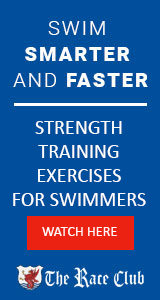Courtesy of Gary Hall Sr., 10-time World Record Holder, 3-time Olympian, 1976 Olympic Games US Flagbearer and The Race Club co-founder.
Whether we turn out to be a better sprinter or endurance athlete is largely determined by the composition of our muscle fibers. There are three types of fibers; slow-twitch (type I) and two types of fast-twitch (types IIa and IIb). Slow twitch fibers are more suitable for endurance events and fast twitch fibers are better suited for short bursts of power and speed. Type IIa fibers have the ability to convert more toward an endurance function (similar to type I) or toward a power function (similar to type IIb), depending on how we train them.
While our composition of muscle fibers is largely genetically determined, we have the ability to increase the size (hypertrophy) and numbers of muscle fibers (muscle mass) and to a smaller degree, alter the function of our type IIa fibers through appropriate training and nutrition. Larger and/or more type II muscle fibers will increase the contractile strength of the muscle. More type I fibers increases our ability to sustain contractions over a longer time.
 The paradox of building too much muscle mass is that it can begin to affect our shape (morphology), making us bigger, which increases frontal drag forces. In most sports, getting bigger and stronger will make us better. In swimming, that is not always the case. At some point, if we continue getting bigger, we will get slower. The additional power will not overcome the additional drag force we create from the added size.
The paradox of building too much muscle mass is that it can begin to affect our shape (morphology), making us bigger, which increases frontal drag forces. In most sports, getting bigger and stronger will make us better. In swimming, that is not always the case. At some point, if we continue getting bigger, we will get slower. The additional power will not overcome the additional drag force we create from the added size.
In summary, a simplified understanding of the physiology for swimmers, coaches and parents includes the following:
1. Identify the anatomical composition of the swimmer’s muscles (this can be estimated by experience in racing or training or by doing a vertical jump)
2. Build the energy systems according to the duration of the events to be swum (most of the swimming events require a robust aerobic system, while sprinting requires more attention to the anaerobic system and stored energy)
3. Teach swimmers to use an appropriate respiratory rate to properly utilize the aerobic system (when required)
4. Design appropriate training in and outside of the pool to improve the composition and size of swim-specific muscle fibers for the targeted events
In the past 2 weeks we have released 3 webisodes on appropriate dryland and strength training for swimmers featuring Indiana University coach Coley Stickels and some of his outstanding post-grad swimmers. Lane 1-4 subscribers will find a great video on strength training, while those in Lanes 3 and 4 will also find a video on boxing for swimmers and another video on some unusual dynamic warm up exercises. We hope you will enjoy these new webisodes!
Yours in Swimming,
Gary Sr.
*Special thanks to Dave Costill, PhD for his contributions to this article

Gary Hall, Sr., Technical Director and Head Coach of The Race Club (courtesy of TRC)
Like The Race Club on Facebook
Follow The Race Club on Instagram
Follow The Race Club on Twitter
Connect to The Race Club / Gary Hall Sr. on Linkedin
THE RACE CLUB
Because Life is Worth Swimming, our mission is to promote swimming through sport, lifelong enjoyment, and good health benefits. Our objective is for each member of and each participant in The Race Club to improve his or her swimming performances, health, and self-esteem through our educational programs, services and creativity. We strive to help each member of The Race Club overcome challenges and reach his or her individual life goals.
The Race Club provides facilities, coaching, training, technical instruction, video, fitness and health programs for swimmers of all ages and abilities. Race Club swim camps are designed and tailored to satisfy each swimmer’s needs, whether one is trying to reach the Olympic Games or simply improve one’s fitness. Our programs are suitable for beginner swimmers, pleasure swimmers, fitness swimmers, USA swimming or YMCA swimmers, or triathletes; anyone who wants to improve swimming skills. All of our Race Club members share an enjoyment of being in the water and use swimming to stimulate a more active mind and body.

